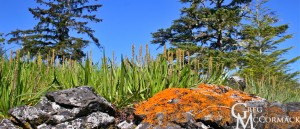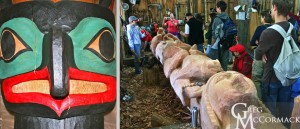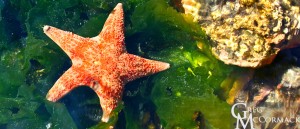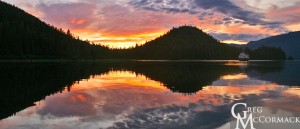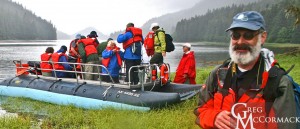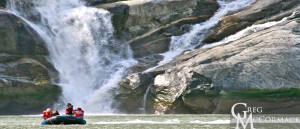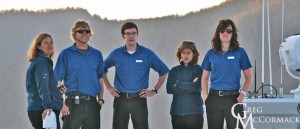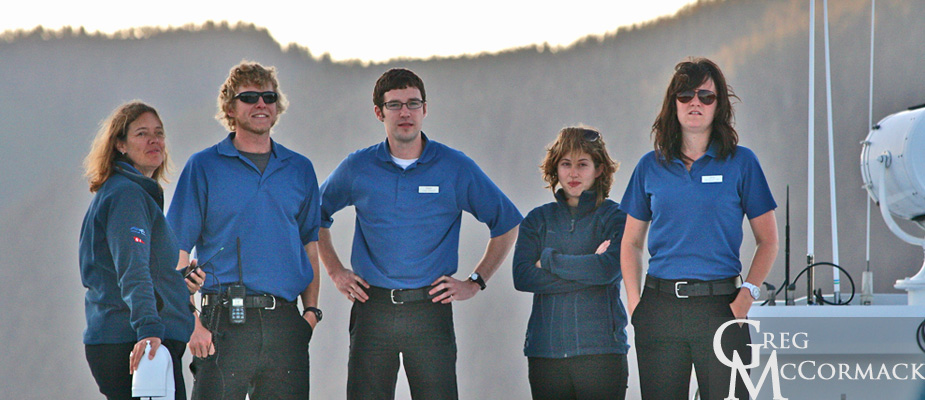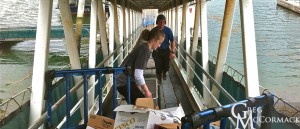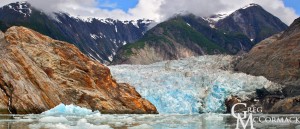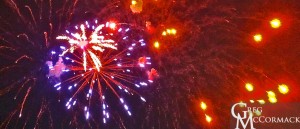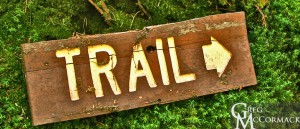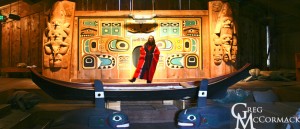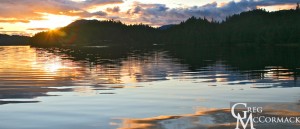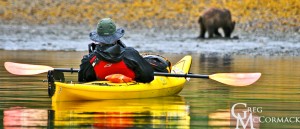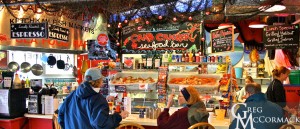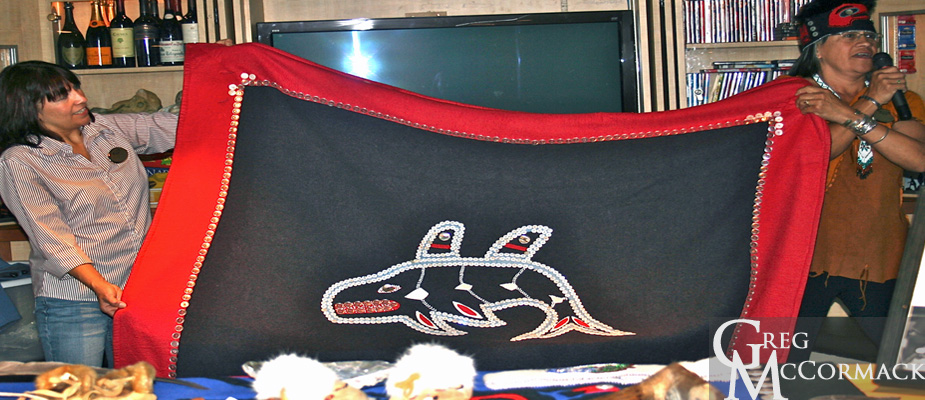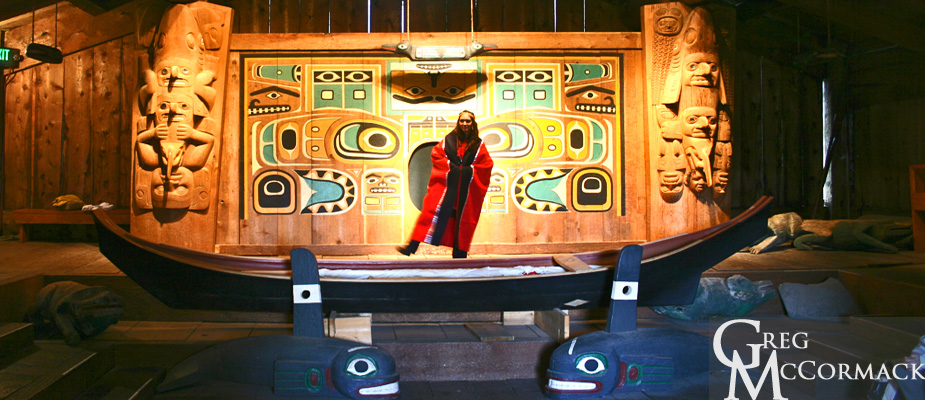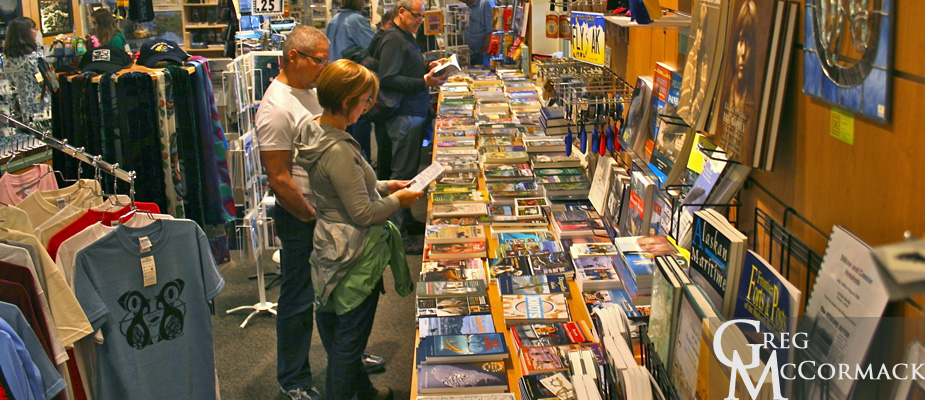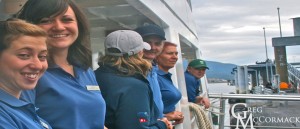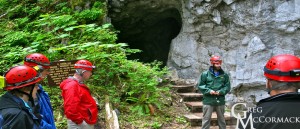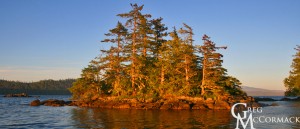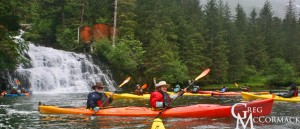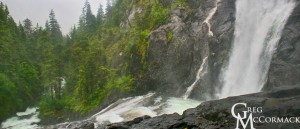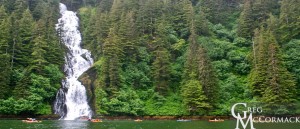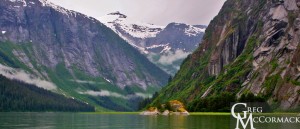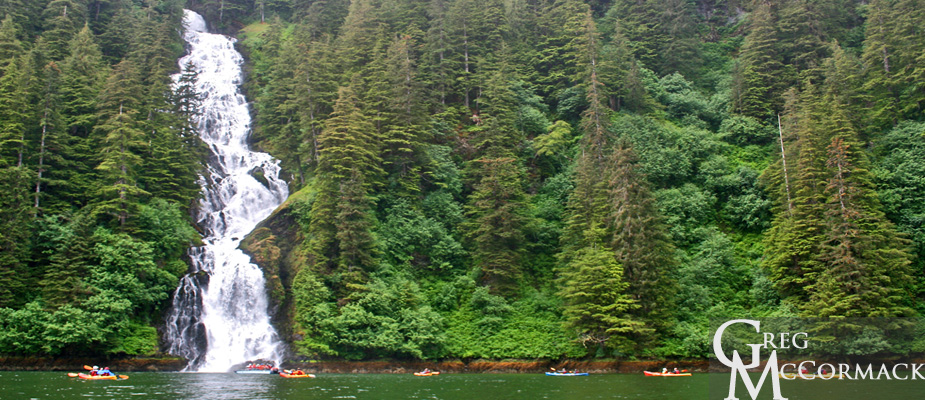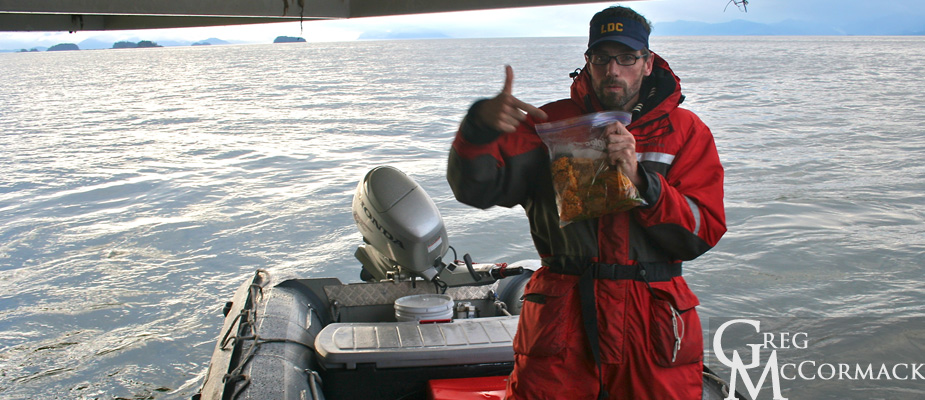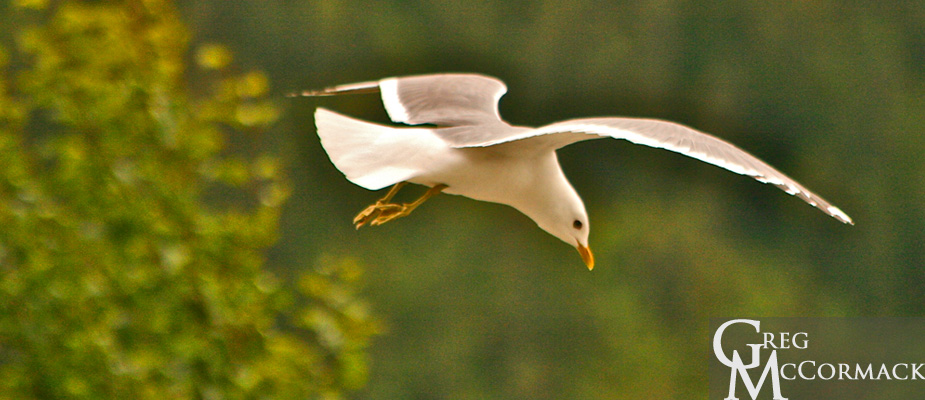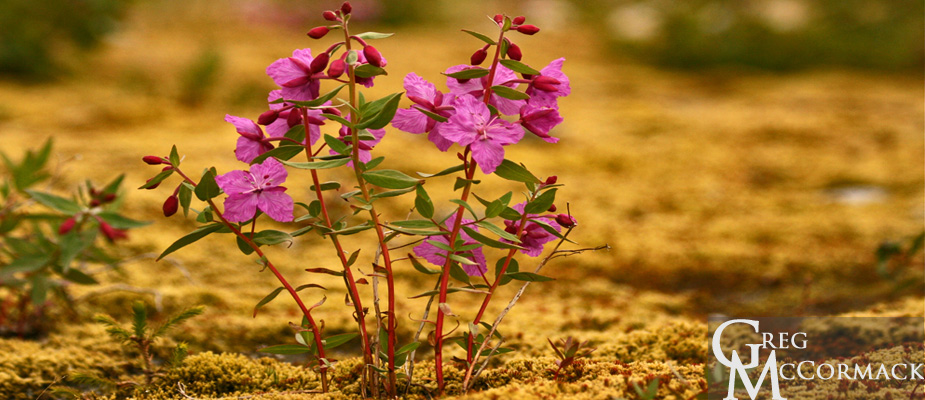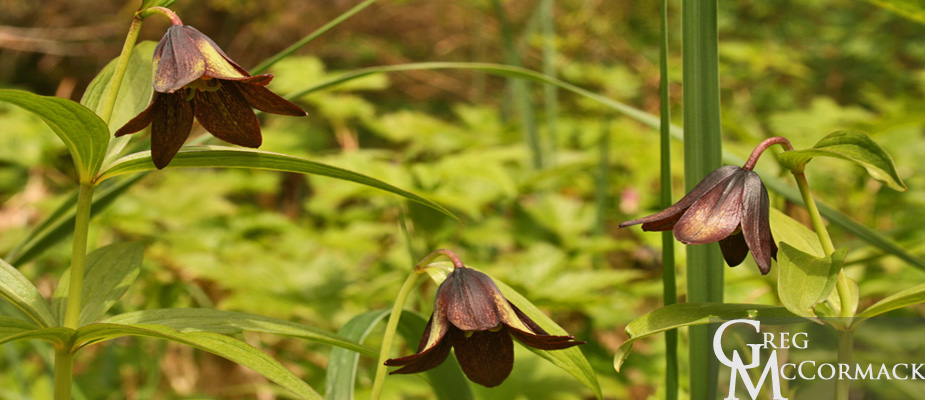Search results
where is gmack now? innersea discoveries expedition week 11
It has been an exciting week on the InnerSea Discoveries Expedition Click Links Below to read daily updates from Week 11 of the Trip:
July 10 – July 16, 2011
Sunday | July 10
“Kayaking, Sauntering, Kelp-Bugling”
Monday | July 11
“Totems, Plankton, Weather”
Tuesday | July 12
“Invertebrates and Our Sister-Ship”
Wednesday | July 13
“Phantasmagorical Seascapes”
“Tidal Ebb & Flow”
Friday | July 15
“Killer Whales”
Saturday | July 16
“The Capitol City of Juneau”
Saturday | July 16
September 26, 2011 by admin
Filed under InnerSea Discoveries
The Capitol City of Juneau
“Find your place on the planet, dig in and take responsibility from there.” –Gary Snyder
“If I were to choose the sights, the sounds, the fragrances I most would want to see and hear and smell–among all the delights of the open world–on a final day on earth, I think I would choose these: the clear, ethereal song of a white-throated sparrow singing at dawn; the smell of pine trees in the heat of the noon; the lonely calling of Canada geese; the sight of a dragon-fly glinting in the sunshine; the voice of a hermit thrush far in a darkening woods at evening; and–most spiritual and moving of sights–the white cathedral of a cumulus cloud floating serenely in the blue of the sky. Edwin Way Teale, “On a Final Day”
Disembarkation day!
It’s off to many different destinations around the country for our guests. It is very tempting to take them up on their offers to stay if ever we visit their hometowns. Juneau is bustling this morning as we dock alongside the pier adjacent to large cruise ships and a float plane dock
A local tells me that the recent U.S. Census had between 5 and 6,000 people moving out of the capital city of Juneau, a drop from around 31,000 to 25k over the last 10 years.
Crew work hard in anticipation of another group that will board in less than 8 hours.
where is gmack now? innersea discoveries expedition week 10
It has been an exciting week on the InnerSea Discoveries Expedition Click Links Below to read daily updates from Week 10 of the Trip:
July 2 – July 9, 2011
Saturday | July 2
TURNOVER DAY = SWABBING THE DECKS
Sunday | July 3
GLACIER CALVING, SEALS & WHALES
Monday | July 4
HAPPY 4TH OF JULY, EVERYBODY!
Tuesday | July 5
MOOSE PELLETS
Wednesday | July 6
CHIEF SHAKES LODGE
SNORKELING AND BANJO PLAYING
Friday | July 8
CLAM-EATING BEAR
Saturday | July 9
“WE NEED THE GREGgle APP!”
Wednesday | July 6
September 14, 2011 by admin
Filed under InnerSea Discoveries
“We abuse land because we regard it as a commodity belonging to us. When we see land as a community to which we belong, we may begin to use it with love and respect.” –Aldo Leopold
Onboard the vessel right after breakfast, we have a couple of Tlingit guests give an informal lecture with songs and a “show and tell” session in the lounge.
We learn many fascinating things about the dynamic Tlingit culture that has thrived here for a very long time.
This is followed by excursions to see petroglyphs, a performance at Chief Shakes lodge and jet boat tours up the diverse Stikine River.
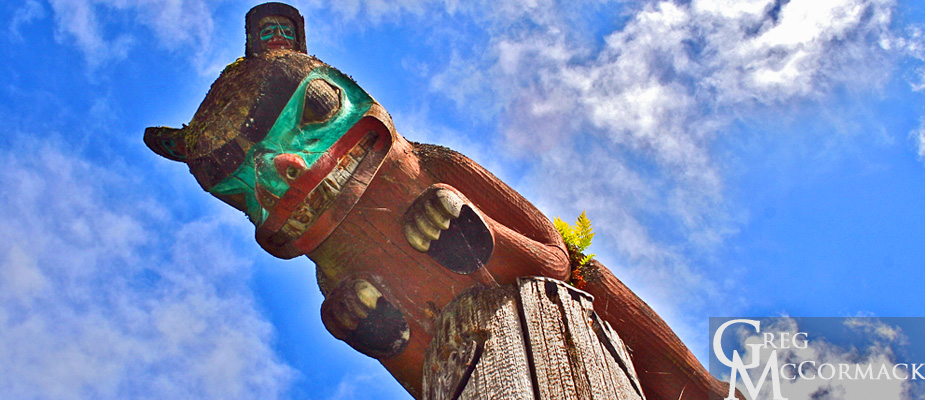
Many folks make the trip to the Nolan Center and purchase natural and cultural history books in the bookstore, among other gift items.
Where is gMack now? InnerSea Discoveries Expedition Week 9
It has been an exciting week on the InnerSea Discoveries Expedition Click Links Below to read daily updates from Week 9 of the Trip:
June 25 – July 1, 2011
Saturday | June 25th
Ketchikan
Sunday | June 26th
El Capitan Passage, Caves and the Oyster Pick-up
Monday | June 27th
Klawock and Sea Otter Sound
Tuesday | June 28th
Little Port Walter
Wednesday | June 29th
Patterson Bay: Scat and Cataracts!
Frederick Sound
Friday | July 1st
The Green Flush and an Ice Swim
Thursday | June 30th
September 10, 2011 by admin
Filed under InnerSea Discoveries
Frederick Sound
Last night we motored into this most stunning of bays on Baranof Island. The majority of guests decide to kayak up the fiord to the splendid waterfall that seems to fall out of the sky down a precipice covered in conifers. Just beyond at the head of the bay on about two hundred acres of mudflats and meadows, a grizzly bear feeds on grasses. Kayakers line themselves along the edge of the river opposite the bear. A bald eagle is perched on a stump, providing another photographic opportunity.
What is the difference between a BROWN bear and a GRIZZLY bear, you may ask? They are the same species, Ursus arctos. The coastal grizzly is called a brown bear. It is significantly larger than the interior grizzly bear because of diet and climate.
Salmon are in abundance along the coast of Alaska. Because the waters of the Gulf of Alaska warm the air enough to moderate the temperatures along the coast, brownies can stay active a couple of months longer than the interior grizzlies. The latter have to deal with temperatures that drop well below freezing, triggering the hibernation response.
We spot a brown bear on the flats and kayak upriver a few hundred meters to get a better look. An eagle perched on a beached stump above the mud-flats was a favorite photo-subject for kayakers.
Later in the day, I get on the marine radio and make a call to the Alaska Whale Foundation. I talk with world-renowned humpback whale researcher Dr. Fred Sharpe. He says that he is available to join us for a talk aboard the ship! We meet him in Frederick Sound and he motors over in his small Zodiac. Fred and I have been friends for over 20 years. He answers lots of questions and entertains guests in the lounge with his humor and knowledge.
After just a half-hour, the swells on this inland sea magically disappear and become glass-like. Humpback whales are spotted “around the clock” in all directions from the ships decks. We estimate at least two dozen whales blowing from just a hundred meters to a couple of kilometers away.
Before disembarking, Fred mentions the influx of nutrients and plankton as a result of the persistent winds we had throughout the morning. Frederick Sound is in the middle of a nutrient-rich geographical area. The plankton feed the schooling fish which in turn feed the leviathans.
Saturday | June 25th
September 9, 2011 by admin
Filed under InnerSea Discoveries
We lift anchor at 0600 and motor a few nautical miles to Ketchikan for disembarkation at 0830. We bid a fond farewell to our old friends and shipmates. It has been a week-long voyage but when we recollect all of the memories, it seems as if we were together for a much longer period of time. We have experienced so much with all of our senses.

After a long and hard push to clean the ship from top to bottom, we wait for our new passenger friends and shipmates to board the M/V Wilderness Discoverer at 1630 hours.
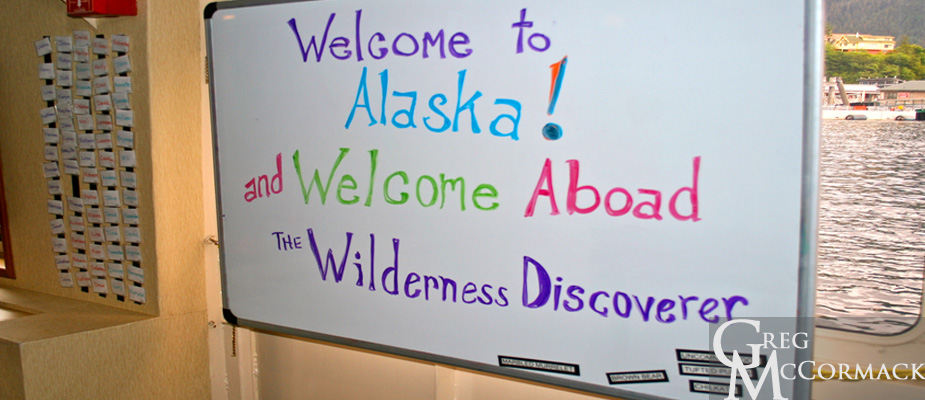
All of us take turns to show guests to their cabins. We meet folks in the lounge for appetizers and “welcome aboard” drinks.
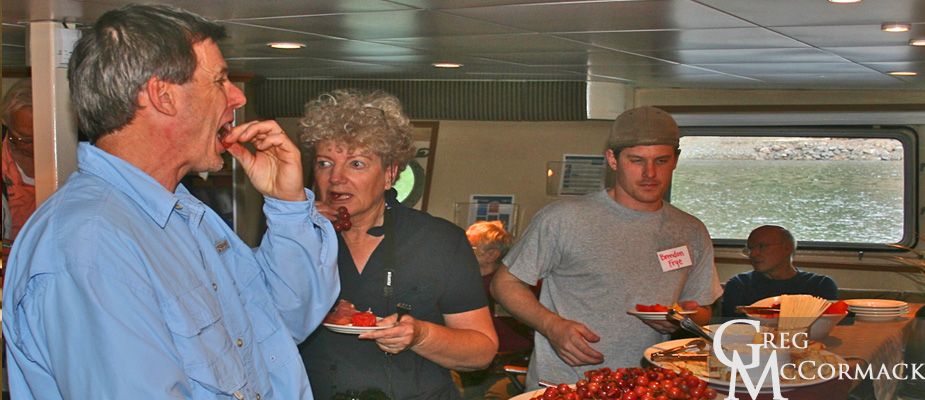
The captain, expedition leader, chief engineer and hotel manager each give a brief introduction to ship-living. We are on our way north up and around Prince of Wales Island.
This evening several of our guest passengers assemble in the lounge and play music. Friends are made rapidly and much merriment ensues.There are suggestions that our company buy some instruments for the vessels night entertainment, such as a Latin percussion box drum and a mid-level guitar, such as a Yamaha or “Ibanez”. Why not add tambourines, shakers with rice, recorders, etc?

Too much fun at night might lead to some weary adventure-seekers during the daytime, so let’s get some rest!
Thursday | June 23
August 8, 2011 by admin
Filed under InnerSea Discoveries
YES BAY
“INTO THE SUBLIME”
Rainy day in the upper reaches of Yes Bay. In the morning, I lead a rainforest walk described as a “fast, technical hike”. We land at the dock of the Yes Bay Lodge, a comfortable fishing lodge with beautiful cabins overlooking the bay and Wolverine River.
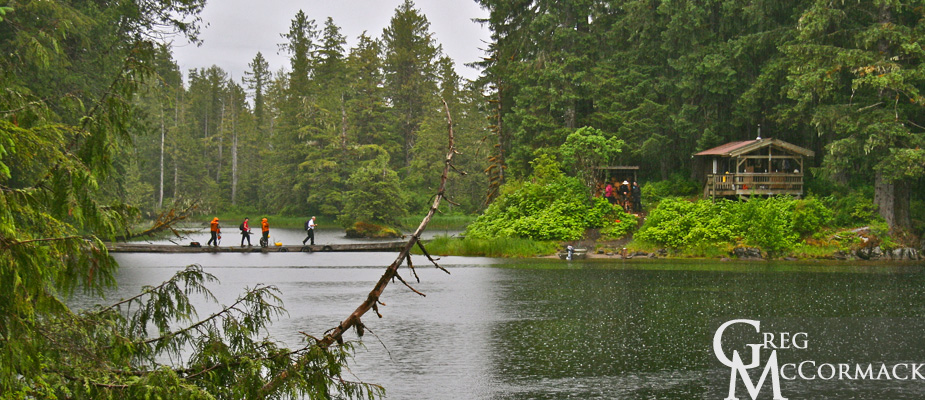
We follow the river about 1.5 miles up to McDonald Lake where a forest service cabin lies on a tiny island. All of us are sopping wet from the overhanging vegetation and have mud covering our shoes, but we are happy to be in the verdant riparian corridor.
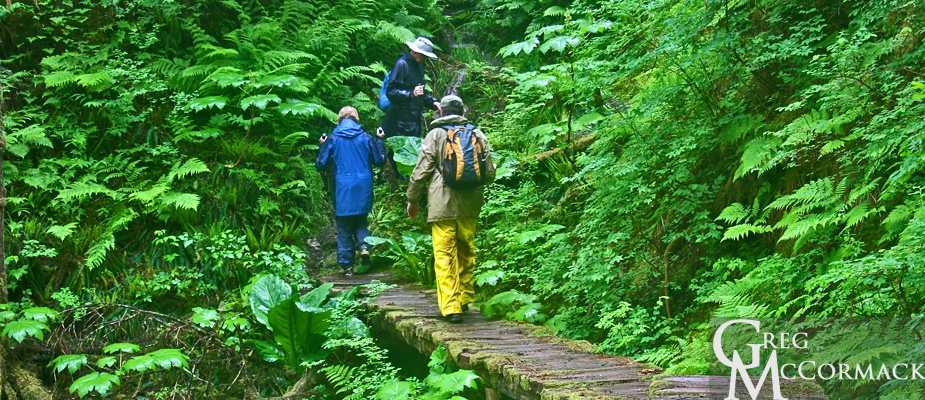
The trail is actually quite technical with lots of slippery roots and rocks, turns and short climbs up and down along the river.
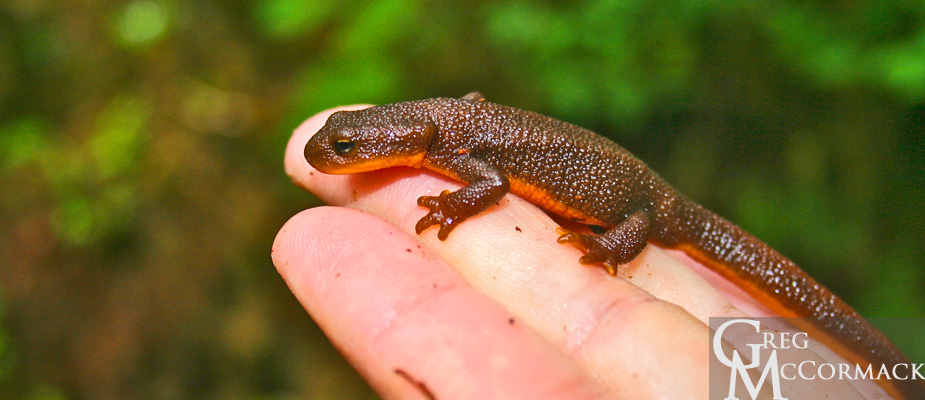
We finally arrive at Lake McDonald and meet some folks renting the Forest Service cabin. They travelled from the draught-ridden state of Texas. They love the verdant countryside and the excellent fishing opportunities. We also meet a couple of forest service rangers that have orange inflatable kayaks for patrolling the shoreline.
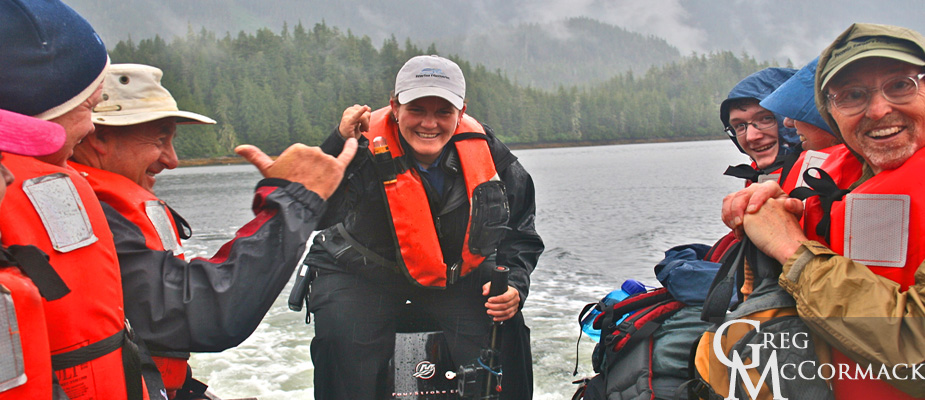
On our way back, we pass a couple of fly fisherman and later at the dock, see deep-sea fisherman returning with King Salmon, lingcod, greenling, rockfish and halibut. Many guests at the lodge do catch and release, but several pay the significant cost of shipping ($250, minimum) the fish home.
In the afternoon, I lead four guests on a quiet kayak up the fiord. The only sound is paddle strokes, the occasional cry of an eagle or call of a thrush. The water is as smooth as glass, except for the tiny concentric circles that emanate from the light, falling rain. This is as close as one can get to perfection…for entering into the sublime—the heart of the Wilderness.
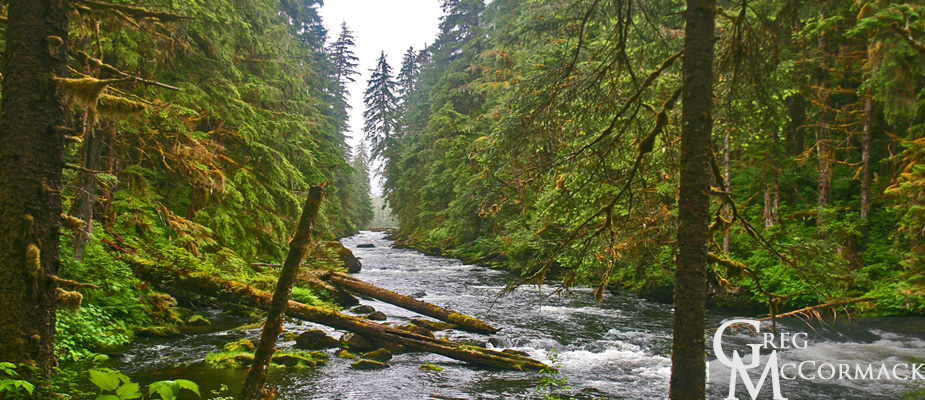
Late in the evening, we send off more than a half dozen double kayaks and 4 stand-up paddleboarders for an after-dinner paddle. The steady drizzle did not deter anyone today, nor did it dampen the spirit of the gung-ho snorkelers. The twin hot tubs on the back of the 300 deck were in full use throughout the day and evening.
Monday | June 20
August 8, 2011 by admin
Filed under InnerSea Discoveries
Thomas Bay and the Baird Glacier
Everyone is very excited for the opportunity to walk up to and on a glacier. First, however, guests have to endure a cold ride on small boats for 30 minutes up the glacial melt-water river to a steep bank drop-off. We disembark on basketball-sized boulders and make our way up to a sandy area where plants are recolonizing the deglaciated landscape.
I draw a large circle in the sand with a stick and receive some quizzical looks from my group of 18 hikers. I explain: “This large circle I’ve drawn is planet earth. I draw some lines north and south of the equator and semi-circles just below the North and South poles.”
I jam my stick into one of the dashed lines on my make-shift earth. “Tomorrow at 12 noon at this location 23-degrees north of the equator there will be no shadow cast. What is the name of this geographical position? Right you are, the Tropic of Cancer! What will happen at this circle just below the North Pole? Yes, exactly 24-hours of daylight…no sunset will be seen at the Arctic Circle at 66-degrees north latitude.”
“The long daylight is the reason the humpback whales swim from Hawaii and the gray whales from Mexico. With such long days in the northern hemisphere, plankton blooms are fed upon by krill and schooling fish which provides sustenance not only for whales but other marine mammals and seabirds as well.”
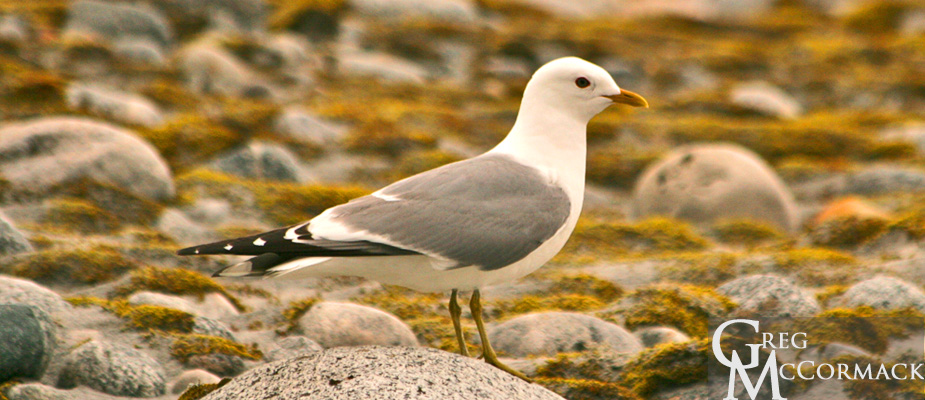
“The Arctic Tern flies up from Antarctica along with millions of migratory birds from central and south America. The long days provide just the right conditions for insects to multiply by the billions. They in turn allow our avian friends to raise not just one brood but two or three with the ability to feed young around-the-clock. If there is a term to describe Alaska and the Far North at this time of year it is “fecund”.”
Just a little bit higher from my scratchings-in-the-sand we are pleased to see so many gorgeous flowers blooming on the moss and lichen-covered rocks.
It’s about a mile walk past the recently colonized outwash plain. Small alders are the next seral stage of plant succession after the mosses and lichens. A few out-of-place sapling conifers such as the spruce and hemlock were seen. They are doomed because there is far too little nitrogen in the soil.
I mention that it will take more than a century from now before the alders give way to the conifers: “We’ll have to make reservations now and come back with our artificial hearts, brains and limbs to see the changes a century or two from now….”
Indeed, glacial rubble to temperate rainforest is a 200-year process from a recently deglaciated landscape. In the wake of the receding glaciers, forests advance and following the greening landscape are mammals, first the herbivores and then the carnivores.
I spot inter-stadial stumps in the terminal moraine. Otherwise known as “fossil wood” which John Muir described in his book “Travels in Alaska”. He actually burned it during his campfires with his Tlingit Indian guides and Presbitarian Missionary friend Samuel Hall Young. Carbon dating techniques in Glacier Bay National Park and Preserve put some of these non-decomposed stumps at 1000’s of years old…at least up until the point where they are exposed to air from erosion, after millennia buried in rubble.
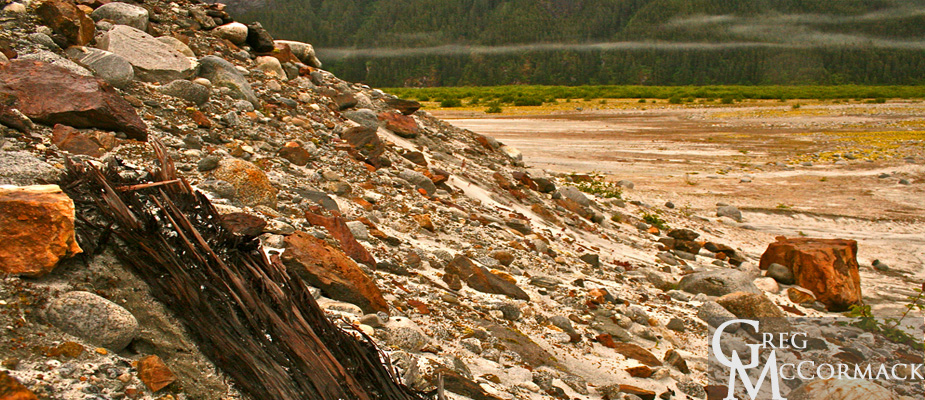
Our trek across the glacier is a favorite activity for our guests. There is the boot-sucking mud that grabs at our boots during our walk. Also, many features of the glacial surface and moraine just in front of the snout keeps you contemplating, for example: What forces are at work to produce such bizarre sand-covered pyramids? They stand several feet high and are covered with fine sand. Most seem to be along a transverse and sutured closed crevasse.
We head back elated from our days adventure for our small boat trip back to the mother ship.
Wednesday | June 15
August 2, 2011 by admin
Filed under InnerSea Discoveries
Patterson Bay & Baranof Island
Everybody onboard is excited and express how their vacation has far exceeded their expectations.
Today is a fabulous day for a kayak, and I have the privilege of leading a small group. There is so much to see and so much to explore in this pristine wilderness area on South Baranof Island.
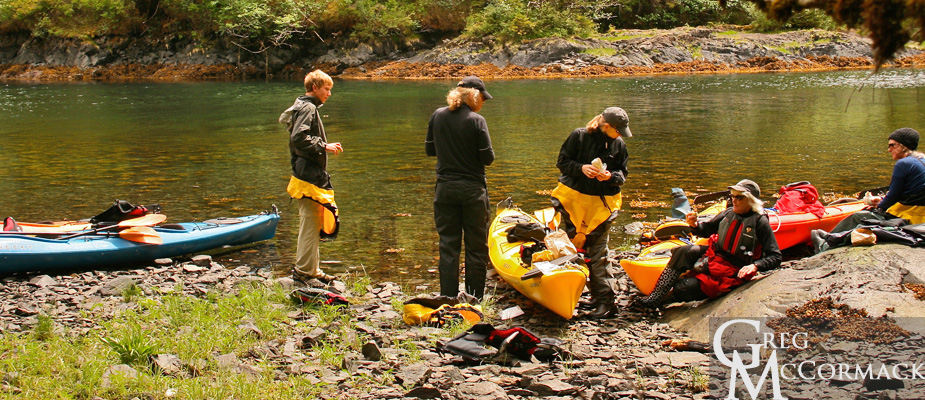
Following are a few notes jotted-down in my “rite-in-the-rain” waterproof journal: “During the last mile or so of my kayak I was pondering how it is possible that each and every day seems to top the last day in terms of excitement. I have often heard folks say that they don’t understand how we can possibly have a better day than the day we just had, and yet, invariably, it happens…day, after day, after day.”
“Undoubtedly, each day brings newness and surprises. Due to the small size of the ship and our collective enthusiasm for being where we are, we have ample opportunities to get to know our fellow travelers. Stories are swapped in the lounge, at the dinner table, in the hot tubs or out on the viewing decks. Everybody seems to be relaxed, in a mood for a great time and certainly not caught up with appearances. Preconceived ideas are dropped from our minds and we allow ourselves to get lost in each and every moment”
“After a certain amount of time hanging-out and getting to know each other, it seems as if we all become exposed to some kind of magic potion that gives us the capacity to be more receptive to the beauty and the power of the place that surrounds us.”
“Certainly we forget unimportant things like what day of the week it is, have little interest in current events in the world and have little time to think about what the boss back home might be thinking. We let go of all worrisome, nagging doubts and become connected to something greater. Is it possible that we are absolutely “in the present”? Have we all arrived at the state-of-being where all that matters is the here and now? I am certain that a significant transformation takes place.”


